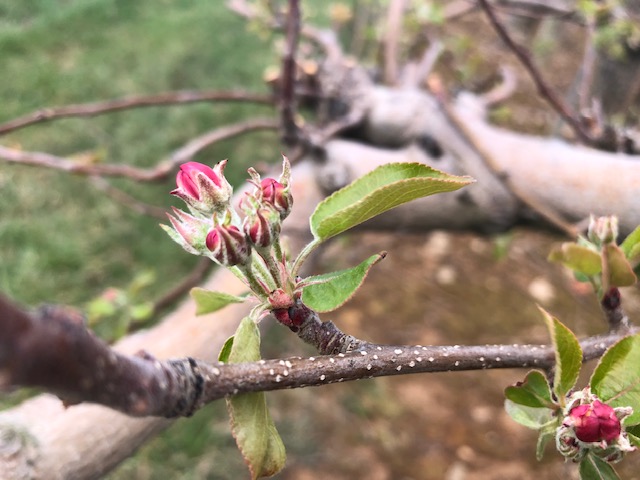
Prohexadione calcium to reduce bitter pit incidence:
– Shoot growth reduction by prohexadione calcium (PC) early in the season (at Pink) can significantly reduce bitter pit incidence in ‘Honeycrisp’ apples.
– PC applications at pink also reduce the incidence of shoot/fire blight.
- Use at the rate of 6 oz/acre.
- PC should not be mixed with calcium or boron.
- Adding a non-ionic surfactant (e.g., Regulaid or LI700) to the tank increases the efficiency of PC applications.
- If the water source contains high levels of calcium carbonate (hard water), add spray-grad ammonium sulfate (AMS) to the spray tank at a rate of (1 lb AMS to 1 lb PC) or according to the product label.
- Don’t spray if rain is expected within 8h of application.
- Both Kudos and Apogee are PC products labeled for use at the pink stage.
Calcium applications:
– Between 15-50 lb of calcium chloride (CaCl2) should be added per acre per year to reduce bitter pit incidence. In other words, 2-8 pound/cover spray.
- Early season applications of calcium (starting @Pink) are more critical than late-season applications.
- Foliar applications of Ca nitrate are not recommended for Delicious and York. They might cause cork-spot-like symptoms.
- Avoid CaCl2 applications at temperatures above 75 oF or under slow drying conditions (e.g., early morning) as this might cause damage to the foliage, especially in sensitive apple cultivars (e.g., Idared and Golden Delicious).
- Soil applications of Ca are not efficient.
- Boron deficiency may reduce Ca movement in the tree.
Boron applications:
– Boron is an essential element for flower development and fruit set, and boron deficiency can negatively affect yield and fruit size.
– Boron is also crucial for Ca movement, and Boron deficiency may lead to Ca-deficiency disorders, including bitter pit.
- Maintenance rate: 0.5-1 lb of Boron/acre (2.5 – 5 lb of Solubor/acre)
- Apply at Pink stage, tank mixed with calcium chloride.
- OR, 7-10 after petal fall; or with the first cover spray.
- Research at WA state showed a significant positive relationship between splitting in Gala and fruit boron content. So, it is recommended to use the lowest rate of boron with Gala.
- Apply at Pink stage, tank mixed with calcium chloride.
Urea applications:
Foliar applications of urea at bloom (3 lb/100 gal) and at petal fall and early cover sprays (5-6 lb/100 gal) can promote cell division, especially for Gala. These applications are particularly important when king blooms, which usually give the largest fruit, are lost to frost.

